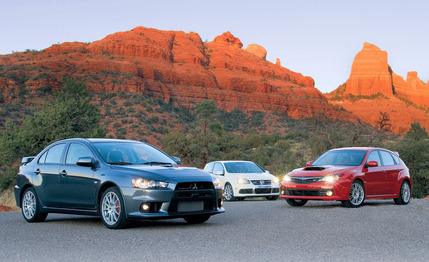 Comparison Tests
Comparison Tests
So you’re ready to spend about 35 large on a car, but you’re put off by a BMW 3-series because it reeks of conformity no matter how well it drives. You’re looking for something more special, a car that’s built with speed as the highest priority. It still has to be an everyday driver, but you want wheels that will get you from here to there as fast as possible in any situation. High-class looks aren’t as important as high-class speed.
If that’s your situation, this is your comparison test. Here are three cars that began as humble economy cars and now have about 19 large worth of speed tacked on: the Mitsubishi Lancer Evolution GSR, the Subaru Impreza WRX STI, and the Volkswagen R32. All three have big power, big brakes, big tires, and all-wheel drive, and if you include the short-lived VW Golf Rallye G60, all three have some rally-racing background.
These cars are on their second platform tours through the U.S., although the previous Evolution technically was available as two versions and the STI underwent a string of running changes. The formula is pretty much the same. The Mitsubishi starts as a Lancer but gets an all-new turbocharged 2.0-liter engine making 295 horsepower and 300 pound-feet of torque. It’s also chock full of technology: four-wheel drive with three electronic programs for the center differential, yaw control, and a trick rear axle that splits power from side to side. Our Evolution GSR came with a five-speed manual and no options. Its price was $33,615, exactly $19,000 more than the cheapest Lancer.
The Subaru also goes the turbo-four route, using the same 2.5-liter horizontally opposed engine as in the previous STI. Updates include a larger intercooler and new cylinder heads, and the resultant output comes in at 305 horsepower and 290 pound-feet of torque. The STI has its own little bag of tricks, too: a three-mode engine-control knob and a center differential that splits the torque front to rear, depending on three automatic or six manual settings, controlled by the driver. The only body style is a five-door, and the only transmission is a six-speed manual. Our test car came with a navigation system but, oddly enough, did not come with the gold BBS wheels that must be ordered first. Add $19,300 to a base Impreza wagon, and you get the as-tested price of $37,440.
The only naturally aspirated car in the group was the Volkswagen. Underneath the body-kitted Rabbit skin is, essentially, the powertrain from an Audi TT 3.2 Quattro. The 3.2-liter V-6 puts out 250 horsepower and 236 pound-feet of torque, managed through a six-speed automated, dual-clutch transmission. The list of gizmos starts and ends with stability control, but the R32 is the luxury car of the group with leather, heated seats, and a sunroof—all standard. Including navigation, the R32 is priced at $19,300 more than a base two-door Rabbit, or $35,430.
The formula for this trio is similar, but the resulting cars are as different as the corporations that spawned them. Picking the best one is a lot like playing rochambeau, or “rock paper scissors” if you didn’t go to Montessori school. It really depends on what you need and what you’re up against, and each car has unique advantages. But that sort of circular logic doesn’t result in clear-cut rankings. So after 400 miles of trekking through central Arizona, here’s how they match up.